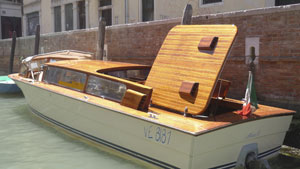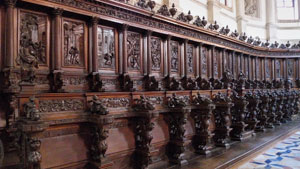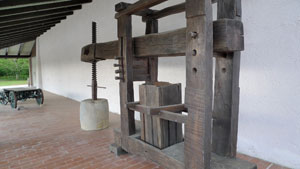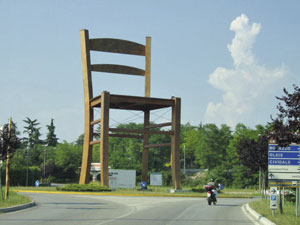 Isn’t it funny that two people can walk through the same town or landscape and find interest in completely different things? On a recent visit to Northern Italy as part of an editorial tour put together by Freud Tools (more on that in a later installment), I found myself strolling along the narrow lanes of Venice, surrounded by flocks of international tourists. Judging by the darting gazes and photos being snapped at warp speed, many of those visitors were taken by a great many of Venice’s charms: buildings brimming with amazing architectural history, ubiquitous canals rippled by gondolas and speedboats, etc.. Some tourists simply stood agape, staring at extravagant shop window displays or hunger-inducing restaurant menus. Many folks just wandered, soaking up the amazing scenery on a glorious day.
Isn’t it funny that two people can walk through the same town or landscape and find interest in completely different things? On a recent visit to Northern Italy as part of an editorial tour put together by Freud Tools (more on that in a later installment), I found myself strolling along the narrow lanes of Venice, surrounded by flocks of international tourists. Judging by the darting gazes and photos being snapped at warp speed, many of those visitors were taken by a great many of Venice’s charms: buildings brimming with amazing architectural history, ubiquitous canals rippled by gondolas and speedboats, etc.. Some tourists simply stood agape, staring at extravagant shop window displays or hunger-inducing restaurant menus. Many folks just wandered, soaking up the amazing scenery on a glorious day.
 But, being a woodworker, I couldn’t help but notice interesting woodworking just about everywhere I roamed. Take, for example, Venice’s ubiquitous water taxis — the preferred and often necessary forms of travel around town. Most of these fiberglass-hulled craft boast ample amounts of “bright work”: clear varnished woods, like mahogany and teak, that comprise their decks, hatch covers, dashboards, interiors and all the associated trim. These long, sleek taxis looked like the Italian versions of the vintage Chris-Craft speedboats sometimes seen cruising proudly on lakes in Eastern and northern-Midwestern states. Every inch of Italian water taxi woodwork that I spied was in terrific shape, which makes me believe that there must be droves of busy wood refinishers in Venice!
But, being a woodworker, I couldn’t help but notice interesting woodworking just about everywhere I roamed. Take, for example, Venice’s ubiquitous water taxis — the preferred and often necessary forms of travel around town. Most of these fiberglass-hulled craft boast ample amounts of “bright work”: clear varnished woods, like mahogany and teak, that comprise their decks, hatch covers, dashboards, interiors and all the associated trim. These long, sleek taxis looked like the Italian versions of the vintage Chris-Craft speedboats sometimes seen cruising proudly on lakes in Eastern and northern-Midwestern states. Every inch of Italian water taxi woodwork that I spied was in terrific shape, which makes me believe that there must be droves of busy wood refinishers in Venice!
One of these watercraft took our Freud group across the grand canal to see the San Giorgio Maggiore, a grand 16th century Benedictine church on the island of the same name. Designed by the famous Roman architect Andrea Palladio and built between 1566 and 1610, the church’s brilliant white marble façade embodies classical renaissance style. It simply gleams above the blue-green waters that surround it. Inside the church, behind the altar and presbytery (the area reserved for the clergy), is the monk’s choir, a room with walls lined with carved wood stalls and seats for the Benedictine monks. Above the stalls, richly carved panels depict religious scenes and create an elegant counterpoint to the stone columns, capitals, and statues seen throughout the church.
 Later in my Italian adventure, our Freud group visited a couple of wineries in the Friuli region of northeastern Italy, famous both as a manufacturing center and as a world-class wine region. The area was simply lovely: endless verdant rolling hills (most covered with well-tended grape vines), with breathtaking views of the snow-capped Alps in the distance. After tasting delicate Sauvignons and Pinot Blancs at the Russiz Superiore winery and touring their impressive cellars, I got another unexpected “wood fix”: They had an ancient wine press on display in front of the tank shed (where the wine is fermented before being put in barrels for aging). Although no one could tell me exactly how old this press was, or even when it had been retired from service, its heavy hand hewn oak beams, handcarved screw and huge dovetail joints were a delight to behold.
Later in my Italian adventure, our Freud group visited a couple of wineries in the Friuli region of northeastern Italy, famous both as a manufacturing center and as a world-class wine region. The area was simply lovely: endless verdant rolling hills (most covered with well-tended grape vines), with breathtaking views of the snow-capped Alps in the distance. After tasting delicate Sauvignons and Pinot Blancs at the Russiz Superiore winery and touring their impressive cellars, I got another unexpected “wood fix”: They had an ancient wine press on display in front of the tank shed (where the wine is fermented before being put in barrels for aging). Although no one could tell me exactly how old this press was, or even when it had been retired from service, its heavy hand hewn oak beams, handcarved screw and huge dovetail joints were a delight to behold.
 The next day, we left for Udine, a medium-sized town in northeastern Italy not far from the Slovenian border. After visiting Freud’s carbide plant and saw blade factory (no wood sightings there; just lots of metal and machinery), we drove through the municipality of Manzano, the self-proclaimed world capital of chair production. This achievement is celebrated by a surprising roadside attraction: a 100-foot-tall chair-shaped monument. But nowadays, there are only 800 chair factories in the area, down from 1,200 just a few years ago. The great majority of the companies are small or medium-sized and family-owned firms and that, at their peak, made 30 percent of all the chairs produced in the world!
The next day, we left for Udine, a medium-sized town in northeastern Italy not far from the Slovenian border. After visiting Freud’s carbide plant and saw blade factory (no wood sightings there; just lots of metal and machinery), we drove through the municipality of Manzano, the self-proclaimed world capital of chair production. This achievement is celebrated by a surprising roadside attraction: a 100-foot-tall chair-shaped monument. But nowadays, there are only 800 chair factories in the area, down from 1,200 just a few years ago. The great majority of the companies are small or medium-sized and family-owned firms and that, at their peak, made 30 percent of all the chairs produced in the world!
Sandor Nagyszalanczy





